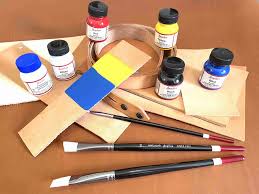Acrylic paint is widely loved for its versatility, fast drying time, and compatibility with various surfaces. But to truly unlock its potential, artists often turn to acrylic paint additives. These are not just optional extras — they can significantly alter the behavior, texture, and finish of your paint, depending on the creative direction you’re heading in.
This article dives into different types of acrylic paint additives, their practical uses, and how they help refine techniques in textural, fabric, and fluid art.
What Are Acrylic Paint Additives?
Acrylic paint additives are substances mixed into acrylic paint to change its natural properties without affecting pigment strength. Unlike mediums, which are usually used to extend paint or alter gloss, additives are more about controlling behavior — things like flow, drying time, texture, and adhesion.
Some additives increase thickness for texture; others slow drying time to allow more blending. There are even those designed specifically for fabric or fluid art.
Acrylic Paint Additives for Texture
Creating texture with acrylic paint can add a new level of depth and dimension to your work. When working on canvas or mixed media, texture additives are often used to build surface variation.
Some commonly used additives for texture include:
-
Modeling paste – used for heavy texture and sculptural effects.
-
Sand gel or pumice gel – for gritty, tactile surfaces.
-
Glass bead gel – to create reflective, granular effects.
Texture additives are ideal for artists looking to step away from flat surfaces and create something more tactile and immersive. They’re especially helpful in abstract and experimental pieces, where physicality becomes part of the visual narrative.
Acrylic Paint Additives for Fabric
Painting on fabric isn’t as straightforward as it might seem. Acrylics on their own can be stiff, prone to cracking, or may not bond properly after washing. That’s where acrylic paint additives for fabric come into play.
Fabric-specific additives:
-
Improve flexibility of the paint.
-
Help the paint bond better with textile fibers.
-
Make the painted fabric more resistant to washing and wear.
These additives are typically mixed directly with acrylic paint and then applied to the fabric using brushes, stamps, or stencils. Once heat-set (usually with an iron), the result is a flexible and durable painted design.
Acrylic Paint Pouring Additives
In the world of fluid art, acrylic pouring additives are essential. Fluid painting relies heavily on achieving the right consistency and behavior of the paint to create smooth blends, cells, and lacing effects.
The most common types of pouring additives include:
-
Flow improvers – thin the paint for better movement without diluting pigment.
-
Silicone oil – used to create cells and separation in the paint layers.
-
Pouring medium – balances flow and drying time, prevents cracking.
These additives don’t just improve technique—they’re necessary for the physics behind fluid art. Without the right additive ratio, the final result can easily fail to match the desired effect.
Choosing the Right Additives for Acrylic Paint
The phrase “additives for acrylic paint” covers a broad range of products, each tailored to a specific goal. When selecting an additive, consider the following questions:
-
Are you working on canvas, paper, or fabric?
-
Is texture important to your piece?
-
Do you want the paint to dry slower, faster, thicker, or thinner?
-
Are you going for a smooth flow or a layered effect?
Understanding what you’re trying to achieve will help you pick the right additive for the job.
Things to Keep in Mind When Using Additives
-
Start small: Always test additives in small batches before committing to a large-scale piece.
-
Mix thoroughly: Incomplete mixing can lead to uneven application or inconsistent effects.
-
Drying time: Some additives can drastically extend or shorten drying time — plan your workflow accordingly.
-
Surface preparation: For fabric or unusual surfaces, prepping the base layer can make a big difference in results.
Acrylic paint additives might seem technical at first, but they open up a vast range of creative possibilities. Whether you’re working on canvas, experimenting with texture, painting on fabric, or exploring the mesmerizing world of fluid art — the right additive can elevate your work from basic to refined.
They’re not just for professional artists either. Beginners can benefit just as much, especially when trying to figure out why paint behaves a certain way and how to control it better.
Art is part skill, part curiosity — and a little chemistry doesn’t hurt either.

